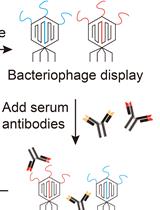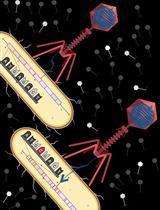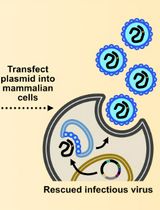- EN - English
- CN - 中文
CRISPR/Cas Gene Editing of a Large DNA Virus: African Swine Fever Virus
一种大DNA病毒(非洲猪瘟病毒)的CRISPR/Cas基因编辑
发布: 2018年08月20日第8卷第16期 DOI: 10.21769/BioProtoc.2978 浏览次数: 9696
评审: Modesto Redrejo-RodriguezCovadonga AlonsoAnonymous reviewer(s)
Abstract
Gene editing of large DNA viruses, such as African swine fever virus (ASFV), has traditionally relied on homologous recombination of a donor plasmid consisting of a reporter cassette with surrounding homologous viral DNA. However, this homologous recombination resulting in the desired modified virus is a rare event. We recently reported the use of CRISPR/Cas9 to edit ASFV. The use of CRISPR/Cas9 to modify the African swine fever virus genome resulted in a fast and relatively easy way to introduce genetic changes. To accomplish this goal we first infect primary swine macrophages with a field isolate, ASFV-G, and transfect with the CRISPR/Cas9 donor plasmid along with a plasmid that will express a specific gRNA that targets our gene to be deleted. By inserting a reporter cassette, we are then able to purify our recombinant virus from the parental by limiting dilution and plaque purification. We previously reported comparing the traditional homologous recombination methodology with CRISPR/Cas9, which resulted in over a 4 log increase in recombination.
Keywords: ASFV (ASFV)Background
African Swine Fever (ASF) is a highly lethal contagious viral disease of swine caused by ASF virus (ASFV). The genome of ASFV consists of a double-stranded DNA genome of approximately 180-190 kilobase pairs. ASFV causes a spectrum of disease, from highly lethal to sub-clinical, depending on host characteristics and the virus strain (Tulman et al., 2009). There is no commercial vaccine for ASFV; experimentally, the only vaccines that have shown to protect against the current circulating strain from the outbreak in Georgia in 2007 (ASFV-G) are live attenuated vaccines that contain one or more deletions to the viral genome, for example: (O' Donnell et al., 2015). Traditionally, gene deletions for ASFV have been performed by homologous recombination where a donor plasmid containing homologous genomic sequences is used for gene deletion (O' Donnell et al., 2015), however this only occurs at a very low rate, making production of recombinant ASFV difficult (Borca et al., 2018).
Recently we reported the use of CRISPR/Cas9 as an alternative approach to introduce gene deletions in ASFV, with a 4 log increase over traditional methods (Borca et al., 2018). This increase, in recombination using CRISPR/Cas9, allows for easier production and purification of recombinant viruses from the parental wild-type. It is possible that using CRISPR/Cas9 will allow for viral protein mutations, expanding our abilities to dissect critical domains for virulence, possibly even in genes that have been previously determined to be essential. This approach has successfully been reported with other large DNA viruses including Orthopox (Okoli et al., 2018), Vaccinia virus (Yuan et al., 2015 and 2016), Herpes Simplex virus (Suenaga et al., 2014) and Pseudorabies (Tang et al., 2016).
Materials and Reagents
- Pipette tips 10 μl, 200 μl, 1,000 μl (Thermo Fisher Scientific, Thermo ScientificTM, catalog numbers: 2140-05 , 2160P , 2079 )
- PrimariaTM 6-well plates (Corning, catalog number: 353846 )
- PrimariaTM Tissue culture flasks T-75 filtered flasks (Corning, Falcon®, catalog number: 353824 )
- 50 ml Conical tube (Corning, Falcon®, catalog number: 352098 )
- Polypropylene microcentrifuge tubes
- T-25 flask (Corning, catalog number: 3056 )
- T-150 flask (Corning, catalog number: 3151 )
- 0.22 μm filter (Corning, catalog number: 430769 )
- African swine fever virus field isolates such as ASFV-G (isolated from infected swine serum and adding serum to swine macrophages to propagate the virus. Titrations were done as described by Enjuanes et al., 1976).
- Yorkshire pigs aged 3-12 months as blood donors
- Cas9 donor plasmid (custom designed for target of interest by blue heron bio. See attached insertion cassette sequence (Supplemental file)
- Fugene HD (Active Motif, catalog number: 32042 )
- gRNA plasmids (custom designed for target of interest by blue heron bio.)
- OptiMEM (Thermo Fisher Scientific, GibcoTM, catalog number: 31985062 )
- Phosphate Buffered Saline (PBS) 1x, pH 7.0-7.3 (Thermo Fisher Scientific, GibcoTM, catalog number: 14190144 )
- 0.5 M EDTA pH 8.0 (Thermo Fisher Scientific, InvitrogenTM, catalog number: 15575020 )
- Ficoll-Paque PLUS density gradient of 1.077 g/ml (GE Healthcare, catalog number: 17144002 )
- RPMI 1640 medium (Thermo Fisher Scientific, GibcoTM, catalog number: 11875093 )
- Gamma Irradiated Fetal bovine serum (GE Healthcare, HycloneTM, catalog number: SH30071.03 )
- Antibiotic-Antimycotic (100x) (Thermo Fisher Scientific, GibcoTM, catalog number: 15240096 )
- Gentamycin (Thermo Fisher Scientific, GibcoTM, catalog number: 15750060 )
- HEPES 1 M (Thermo Fisher Scientific, GibcoTM, catalog number: 15630080 )
- L-Glutamine, 200 nM (Thermo Fisher Scientific, GibcoTM, catalog number: 25030081 )
- L929 media (L cell, L929, derivative of Strain L) (ATCC, catalog number: CCL-1 )
- Heparin (Sagent Pharmaceuticals, catalog number: 400-10 )
- L929 conditioned media (see Recipes)
- Macrophage Wash Media (see Recipes)
- Macrophage complete media (see Recipes)
- PBS + EDTA (see Recipes)
Equipment
- P1,000, P200, P20, P10 Pipettes (Gilson)
- 2 Liter roller bottles (Corning, catalog number: 431329 )
- 250 ml centrifuge bottles (Thermo Fisher Scientific, Thermo ScientificTM, NalgeneTM, catalog number: 3141-0250 )
- Inverted Fluorescent Microscope (Carl-Zeiss)
- Hematocytometer
- Pipet aid (Drummond Scientific, catalog number: 4-000-101 )
- Tabletop Centrifuge (Eppendorf, model: 5810 )
- Floor Centrifuge (Thermo Fisher Scientific, Thermo ScientificTM, model: Sorvall® RC-4 )
- Sorval SLA-1500 fixed angle rotor (Thermo Fisher Scientific, model: SLA-1500 )
- Vortex mixer (Fisher Scientific, catalog number: 12-812 )
- -70 °C freezer (Thermo Scientific, model: ULT2586-9-A40 )
Procedure
文章信息
版权信息
© 2018 The Authors; exclusive licensee Bio-protocol LLC.
如何引用
Borca, M. V., Berggren, K. A., Ramirez-Medina, E., Vuono, E. A. and Gladue, D. P. (2018). CRISPR/Cas Gene Editing of a Large DNA Virus: African Swine Fever Virus. Bio-protocol 8(16): e2978. DOI: 10.21769/BioProtoc.2978.
分类
微生物学 > 微生物遗传学 > 诱/突变
分子生物学 > DNA > 诱/突变
您对这篇实验方法有问题吗?
在此处发布您的问题,我们将邀请本文作者来回答。同时,我们会将您的问题发布到Bio-protocol Exchange,以便寻求社区成员的帮助。
提问指南
+ 问题描述
写下详细的问题描述,包括所有有助于他人回答您问题的信息(例如实验过程、条件和相关图像等)。
Share
Bluesky
X
Copy link













